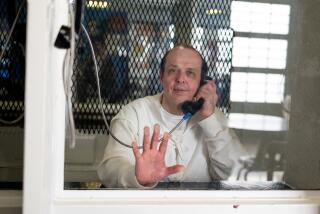Doctor: Sedation May Fail in Executions
SAN JOSE — Some condemned inmates executed by lethal injection may have been conscious when they received a drug that causes suffocation and “excruciating” sensations comparable to drowning or strangulation, an anesthesiologist who has reviewed state execution logs testified Wednesday.
Dr. Mark Heath, a professor of anesthesiology at Columbia University Medical School, said the logs showed that inmates were still breathing several minutes after prison personnel administered pancuronium bromide, a paralytic and the second of three drugs used in lethal injections in California and three dozen other states.
The inmates are supposed to be heavily sedated by the first drug against the pain of the third, a heart-stopping chemical whose effects are masked by the paralytic.
“If someone is breathing like that, they may not be in a deep plane of anesthesia. They may not even be unconscious,” Heath said on the second day of a hearing on death row inmate Michael Morales’ challenge to California’s lethal injection procedures.
Morales’ attorneys contend that the executions violate the U.S. Constitution’s prohibition against cruel and unusual punishment. As Heath, who has testified as an expert challenging lethal injection procedures in several states, spoke, attorney Ginger Anders displayed a copy of a prison log of the March 2001 execution in California of murderer Robert Lee Massie.
The log showed that Massie continued to breathe for four minutes after the paralytic, pancuronium bromide, was administered.
Heath emphasized that two doctors who observed the execution “said they saw breathing; they were right there.”
Still, under cross-examination by senior Assistant Atty. Gen. Dane Gillette, Heath acknowledged that he did not have sufficient information to say whether any particular inmate was conscious when the paralytic was applied or during the painful cardiac shutdown.
“We don’t know whether they were or weren’t,” Heath said.
In more than a full day of testimony, Heath presented a withering portrayal of the California lethal injection system at work, based on his review of prison records, depositions of execution team members and other material obtained by Morales’ attorneys.
Among other things, he said members of the execution team were ignorant of the properties of the drugs they administered, and in some instances failed to give the required dose of the sedative sodium thiopental.
Responding to a question about how much she knew about the anesthetic, a registered nurse with primary responsibility for mixing the drugs said, “I don’t study. I just do the job. I don’t want to know about it,” according to a deposition read into the court record by Anders.
Heath said he was disturbed by the response: “This is problematic. She is being negligent.... You can’t understand and appreciate the dangers if you don’t know how the drug works.” The same nurse said she was not familiar with the lethal drug protocol, which Heath said he found “almost hard to believe.”
He also said it was “appalling” that another member of the team, involved with administering the lethal dose, did not know the names of the second and third drugs, according to deposition testimony read in court Wednesday.
Heath testified that he also was troubled by reports of a discussion between the governor’s representatives and the attorney general’s office about changing lethal injection procedures. The meeting was called after U.S. District Judge Jeremy Fogel announced that he would hold a detailed hearing on Morales’ constitutional challenge.
According to notes of the meeting taken by Corrections attorney Bruce Slevin, Dr. Robert Singler, who works for the department, suggested that the state use a different, longer-lasting and more effective anesthetic. But lawyers spurned Singler’s idea, saying they thought the state should not change course because the three-drug protocol had been upheld by courts. Instead, they suggested that the procedure be “tweaked,” Heath testified.
“Fewer changes will be better,” said Andrea L. Hoch, the governor’s lawyer, according to Slevin’s notes, which were displayed on a courtroom screen.
Heath also expressed dismay that the room in which prison personnel monitored the execution was dimly lighted to preserve the confidentiality of members of the execution team.
Heath observed the room, under execution conditions, on a tour arranged by Fogel earlier this year. “All I can say is that it was much darker than I ever would allow myself to be placed” when working in a hospital setting, Heath said.
The 46-year-old anesthesiologist cited testimony of a physician who was present at an execution as an observer. The doctor said “he had to use a flashlight to see what he was writing,” Heath stated.
Heath said there is no way to guarantee that an inmate is adequately anesthetized unless an experienced doctor is at his side monitoring consciousness during the execution. The California protocol does not call for a doctor to participate, and the execution team is in a room adjacent to the execution chamber, pumping in the drugs through intravenous lines.
Heath said he thought it possible to recruit a suitable monitor, even though the American Medical Assn. and the American Society of Anesthesiologists have urged their members not to participate in executions. Medical professionals’ oaths -- “First, do no harm “ -- condemn participating in killings.
On cross-examination, Heath said he would not want to participate in an execution. When Gillette asked if Heath would help the state devise a “humane” lethal injection protocol, the doctor, who opposes the death penalty, said it would violate his personal ethics.
Gillette attempted to demonstrate in various ways that no change in the state’s procedures would satisfy Heath. For example, he noted that Heath’s declarations in the Morales case and an earlier one brought by death row inmate Kevin Cooper had stated that a continuous infusion of sodium thiopental would provide an additional measure of safety. Now, Gillette suggested, Heath was criticizing the state’s plan to adopt the continuous infusion protocol.
Heath countered that he “could not have imagined that when California made that change in the protocol that it also would dramatically lower” the initial dose of the sedative.
Currently in California, “no one on the [execution] team” at San Quentin has the training or experience to monitor or assess whether the anesthetic is really working, Heath said.
“This is not the fault of these people. They are doing the best they can in a very dysfunctional system,” he testified.
Morales is on death row for the 1981 murder of Terri Winchell, a Lodi high school student.
More to Read
Sign up for Essential California
The most important California stories and recommendations in your inbox every morning.
You may occasionally receive promotional content from the Los Angeles Times.











